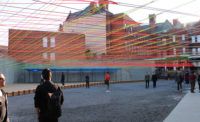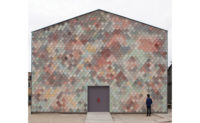Firm to Watch: Escobedo Soliz Studio

Escobedo Soliz Studio
Escobedo Soliz Studio won a competition for an unbuilt mobile pavilion called Mextrópoli, a tensile structure made out of a circular bamboo truss.
Photography © Escobedo Soliz Studio

Escobedo Soliz Studio
Escobedo Soliz Studio founders Andres Soliz Paz and Lazbent Pavel Escobedo Amaral.
Photography © Escobedo Soliz Studio

Escobedo Soliz Studio
Escobedo Soliz Studio’s scheme for the canopylike MoMA PS1 pavilion
Photography © Escobedo Soliz Studio

Escobedo Soliz Studio
Escobedo Soliz Studio designed a rural Mexican church.
Photography © Escobedo Soliz Studio




Architects & Firms
Escobedo Soliz studio, a two-man operation based in Mexico City, is the kind of underdog architecture firm you want to root for. Despite having limited funds, zero built work, and a combined age approximating that of the average AIA member, the pair has developed a scrappy work ethic in tandem with a strong appreciation of context and materials. That approach helped them land one of the most coveted commissions for emerging firms—the courtyard pavilion design for MoMA PS1’s Young Architects Program in New York.
“Architecture schools in the U.S. have more technological resources. In Mexico, we are more pragmatic,” says partner Andres Soliz Paz. “We ask ourselves, how can we build with the things we have in our hands?” Soliz Paz, 25, and Lazbent Pavel Escobedo Amaral, 27, met on their first day studying architecture at the National Autonomous University of Mexico, one of Latin America’s most prestigious academic institutions. Despite coming from different regions of Mexico, they hit it off immediately, discussing art and architecture, swapping books, and collaborating on school projects.
In 2011, 2½ years into their studies, they received a commission for a house from a friend’s father. The job ultimately fell through, but they decided to consider it a learning experience and seek work with broader impact. Says Escobedo Amaral, “We wanted to make a real contribution.” With the guidance of professors, they developed a thesis project for a community on the Yucután Peninsula in need of a new chapel and civic space. Rather than build a structure with all-new materials, Soliz Paz and Escobedo Amaral proposed repurposing the timber from the deteriorating existing church for a new pitched-roof sanctuary and ancillary community rooms. While the project still needs funding, it received second place in the Holcim Awards’ “Next Generation” category for Latin America in 2014, a prize honoring sustainable construction.
The Holcim award brought Escobedo Amaral and Soliz Paz to New York for the first time last autumn to participate in a workshop. On a whim, the two took a trip to Long Island City, Queens, to visit MoMA PS1 and began to seriously consider a design for the Young Architects Program competition. “We didn’t think previous pavilions used the whole space,” says Soliz Paz. “We said, ‘let’s approach it as we do in Mexico.’ ”
Rather than place a single object in the middle of the courtyard, Escobedo Amaral and Soliz Paz’s design utilizes the tie holes in the concrete walls to weave a colorful canopy over the entire space, evoking a Mexican street market. The scheme includes the requisite customary water elements, including a sand-covered “beach,” mist nozzles, and a wading pool for happy partygoers. It’s a clear departure from past installations, which have been made of everything from water filtration tanks to corn-smut bricks.
The jury—which included MoMA’s director, Glenn Lowry, and chief curator of architecture and design, Martino Stierli, plus PS1 director Klaus Biesenbach—was impressed with the proposal, and Escobedo Soliz Studio was announced the winner in February, the first Mexican winner in the competition’s 17-year history. “Using the wall’s rebar was not only ingenious, but it suggested that it was possible to intervene in a sensitive way,” says Sean Anderson, associate architecture curator at MoMA. “We’re not looking at it, but experiencing it.”
After the temporary pavilion opens this June, the pair will begin work on a house for Escobedo Amaral’s brother in Tepic, Mexico. They will also organize a workshop with other young Mexican architects and will continue to develop their Mexican projects.*
Though thrilled by their recent recognition, Escobedo Amaral and Soliz Paz want to take their time to develop as a practice. They draw inspiration from modernist heavyweights like Luis Barragán, Louis Kahn, and Alvar Aalto but daydream and watch films to get ideas for designs. First, says Soliz Paz, “we think in atmospheres more than in shapes.”
*In the print version of this article, Soliz Paz stated plans to attend Delft University of Technology this fall for a master’s degree in urbanism. Since then, Soliz Paz has deferred admission for one year to pursue projects with his studio.










